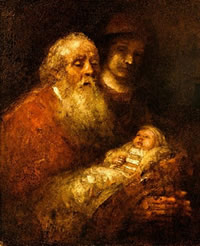
Feast of the Holy Family Year B
Today much is at stake, when what the family stands for is under attack. It is through sharing in family love and responsibilities that we find ourselves as persons. It is normally in the love and support of the family that we find the resources to face the setbacks of life. And what family is there that does not know pain and suffering? Today’s liturgy reminds us that, because ‘he became in every way like us’ (Phil 2:7), our Saviour has shared in the ups and downs of family life.
Our reading from Genesis reminds us of the strength we can find in family traditions. Taking part in the life of old Israel, the family of Jesus shared in the boundless hopes – as vast as ‘the stars of the heavens’ and ‘the sands on the seashore’ – that found expression in the stories of God’s promises to Abraham. The second reading, from Hebrews shows the first Christians rejoicing in the fulfilment of these hopes. They saw the wanderings of Abraham as making him a model of God’s people, as they come to terms with the fact that their true home is not any earthly city. And they saw, in Isaac, the son Abraham was ready to sacrifice - given back to him from the dead, as it were - a foreshadowing of the Son the Father gave up for our salvation.
The tableau sketched by Luke in today’s gospel text, brings us insights into the life of the Holy Family. Joseph and Mary were faithful to the traditions of Israel. (This is significant, coming from Luke the Gentile convert – pointing to the essential continuity of the two covenants: salvation for old Israel, he implies, comes through fidelity to the authentic traditions of the old covenant.) Though Joseph’s carpenter trade would have given this family some security, they did not find it easy to make ends meet. The offering they made, of doves and pigeons, is the more modest offering permitted to the poor (cf. Lev 121:8). Their home was probably a cave dug into the side of a hill, with a small extension in front, and a floor that was simply clay beaten hard by the feet of the household (B. Vawter). This family belonged to the ‘anawim’, the simple people championed by the prophets who, in the struggle of life, kept alive the true spirit of Israel, through trust in their God.
To create his tableau, Luke has united two separate rituals. The firstborn of a Jewish family – who belonged to the Lord – was ‘redeemed’ through the ritual payment of five silver shekels. This ceremony did not necessarily take place in the temple. In a separate ritual, a Jewish mother, five weeks after the birth of a son, came for ceremonial purification. Luke intends his tableau to show the Lord’s coming to his temple – a beloved theme of true believers in old Israel, and looked forward to as the fulfilment of the hopes of the nation. ‘Suddenly the Lord whom you seek will come to his temple’, the prophet Malachi foretold, ‘Who will be able to withstand the day of his coming?’ (3:1-2). Luke’s narrative often uses the device of pairing a man and a woman, expressing their equal dignity under the Gospel. Here he sees Simeon and Anna, meeting with the parents of Jesus, as the fulfilment of the longings of the ‘anawim’, movingly expressed in the canticle of Simeon, ‘Now, Master, you can let your servant go in peace’, and in Anna’s praise and rejoicing.
The ‘salvation’ being inaugurated is universal, ‘for all the nations’, one of Luke’s favourite themes. But it will come through the Cross. The family that returns to the hidden life of Nazareth is very close to the world’s families in their ups and downs.
John Thornhill sm

